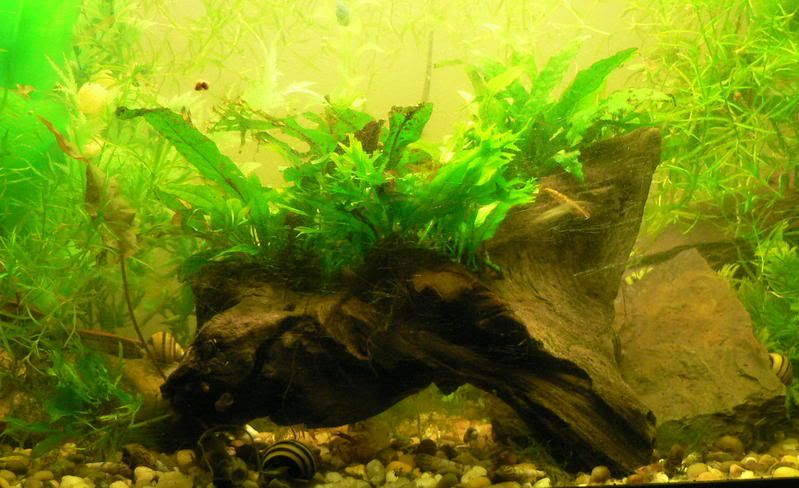By the way, I'm new to the forum, here's a little introduction about my tanks and shrimp. I have had shrimp (amano and cherry) for a while in various tanks, and just set up a 10g tank to breed cherry shrimp. This makes tank number 13 set up
What's with the wood?
Moderator: Mustafa
What's with the wood?
I have been wondering what it is that shrimp like about driftwood. Both in my tanks and the ones at the LFS the shrimp really like hanging out on it (both amano and cherries). Does anyone know what it is they eat on it or what it provides for them?
By the way, I'm new to the forum, here's a little introduction about my tanks and shrimp. I have had shrimp (amano and cherry) for a while in various tanks, and just set up a 10g tank to breed cherry shrimp. This makes tank number 13 set up I have bred cherries in a 10g tank with endlers livebearer males and pygmy cories, but wanted them to have their own space. All of my adult shrimp finally died, but I have at least 20 offspring left. I think the nitrates in the shared tank were just too high for them.
I have bred cherries in a 10g tank with endlers livebearer males and pygmy cories, but wanted them to have their own space. All of my adult shrimp finally died, but I have at least 20 offspring left. I think the nitrates in the shared tank were just too high for them.
By the way, I'm new to the forum, here's a little introduction about my tanks and shrimp. I have had shrimp (amano and cherry) for a while in various tanks, and just set up a 10g tank to breed cherry shrimp. This makes tank number 13 set up
Re: What's with the wood?
It is likely that the wood is covered in micro-algae and other foods the shrimp love.Lotus wrote:I have been wondering what it is that shrimp like about driftwood. Both in my tanks and the ones at the LFS the shrimp really like hanging out on it (both amano and cherries). Does anyone know what it is they eat on it or what it provides for them?
- Shrimpmania
- Shrimp

- Posts: 109
- Joined: Sun Dec 26, 2004 9:13 pm
- Location: S'pore
- starrystarstarr
- Egg

- Posts: 24
- Joined: Sat Mar 17, 2007 4:06 pm
- Location: Brownsville, Texas
- Contact:
- Invader_Xan
- Egg

- Posts: 19
- Joined: Sat Mar 24, 2007 4:26 pm
- starrystarstarr
- Egg

- Posts: 24
- Joined: Sat Mar 17, 2007 4:06 pm
- Location: Brownsville, Texas
- Contact:
- starrystarstarr
- Egg

- Posts: 24
- Joined: Sat Mar 17, 2007 4:06 pm
- Location: Brownsville, Texas
- Contact:
- badflash
- Master Shrimp Nut

- Posts: 2542
- Joined: Sat Sep 24, 2005 1:06 pm
- Location: Wappingers Falls, NY
- Contact:
Sharing is what this group is all about. The hard part is asking the right question, sort of like in Irobot.
You ask the question, if we know it, we'll answer it. You might get a slap if you didn't do a search first though
The info in this forum is amazing. Those "slaps" keep th noise to a bearable level so the search can actually pull up info.
You ask the question, if we know it, we'll answer it. You might get a slap if you didn't do a search first though
The info in this forum is amazing. Those "slaps" keep th noise to a bearable level so the search can actually pull up info.
- apistomaster
- Tiny Shrimp

- Posts: 75
- Joined: Sun Apr 29, 2007 4:04 am
- Location: Clarkston WA 99403
I have been breeding ornamental shrimp for about three years now and it did not take long to realized they have a strong affinity for wood substrates. I suspect there are many reasons for their preference for drift or waterlogged wood.
1. Shrimps have a stong instinct to have a firm feet holds and would, however smooth it may appears provides the micro-profile to assure them a firm anchoring grip while feeding.
2. Wood substrate does promote a diverse microecology of edible microorganisms andcrevices tha zoae can seek safe shelter and food allin one.
3. It is a natural material present in abundance in the hydrological habitats they have evolved and specialized to take advantage of.
I have my highest productivity in my shrimp tanks that have been provided the most wood in addition to aquatic plants and algaes.
I'm sure there is even more than these few points I have not thought of that are involved.
1. Shrimps have a stong instinct to have a firm feet holds and would, however smooth it may appears provides the micro-profile to assure them a firm anchoring grip while feeding.
2. Wood substrate does promote a diverse microecology of edible microorganisms andcrevices tha zoae can seek safe shelter and food allin one.
3. It is a natural material present in abundance in the hydrological habitats they have evolved and specialized to take advantage of.
I have my highest productivity in my shrimp tanks that have been provided the most wood in addition to aquatic plants and algaes.
I'm sure there is even more than these few points I have not thought of that are involved.
- ToddnBecka
- Shrimpoholic

- Posts: 363
- Joined: Wed May 24, 2006 11:12 pm
- Location: Western Maryland
I just received a good-size chunk of driftwood with several java ferns attached. Obviously, it has spent some time in an aquarium already, and the shrimp had a ball cleaning it thoroughly. The dwarf cray's seem to like it as well, I've seen several climbing around on the new addition to their world.

